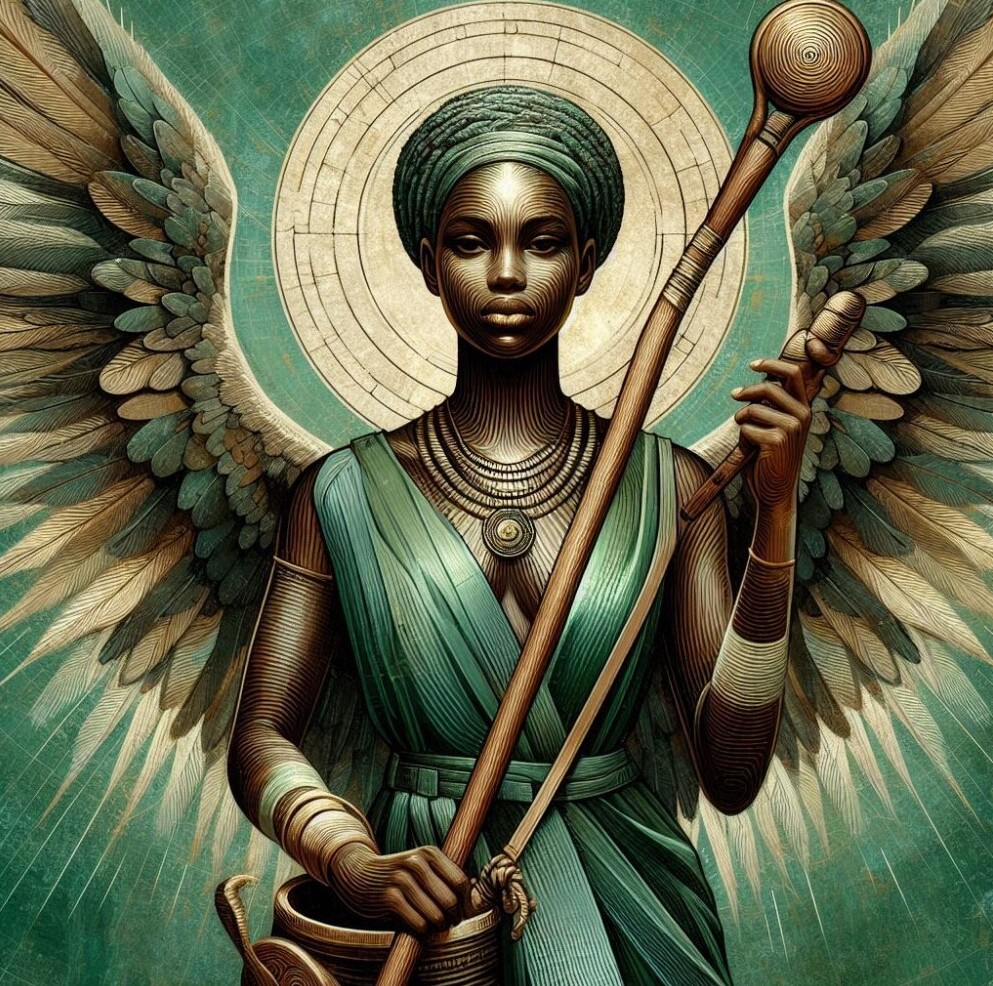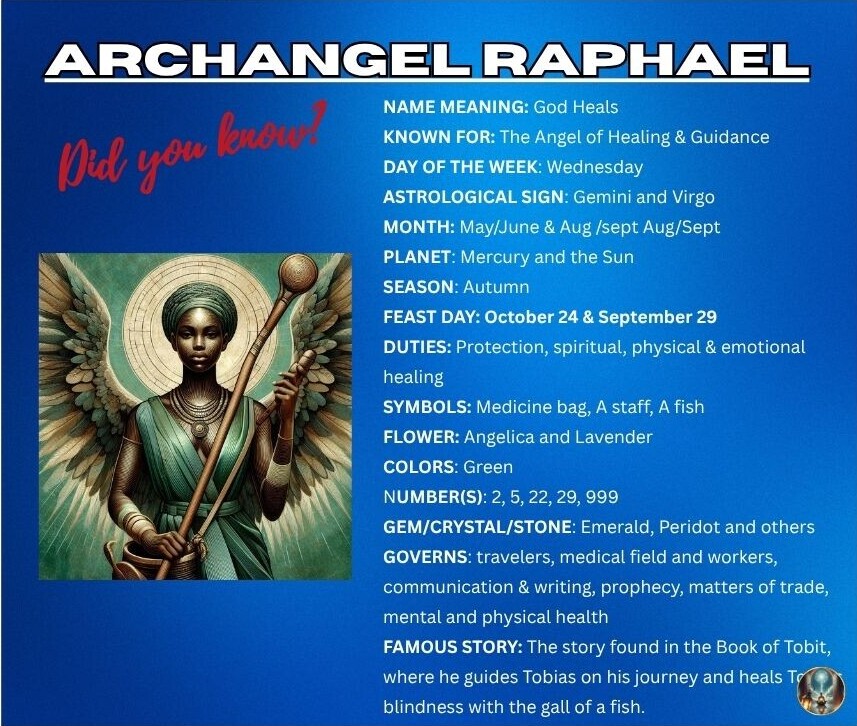
Archangel Raphael is a figure steeped in history and mystery, tracing back to ancient religious texts. Revered as a symbol of healing and protection, Raphael first makes a notable appearance in the Book of Tobit, where he guides and cures those in need. In this tale, he steps in to help heal Tobit’s blindness and protect his son, Tobias, demonstrating his Divine role as a healer and guardian.
Throughout different religious traditions, Raphael’s presence varies but always highlights his traits of compassion and healing. While predominantly recognized in Judeo-Christian texts, aspects of Raphael’s influence can be found across various cultures and scriptures, each attributing a unique perspective to his character.
Culturally, Raphael has had a significant impact on art and literature throughout history. From stunning frescoes of the Renaissance period to modern reinterpretations, his image as a heavenly protector permeates. His depictions are often designed to evoke comfort, hope, and the healing faith he inspires in believers.
Understanding the cultural and historical backgrounds of Archangel Raphael helps appreciate his role beyond mere mythology. His story encourages a deeper look into his impact on spiritual healing and protection narratives, revealing why he remains a prominent figure across time.
Meaning Behind the Name: Archangel Raphael
The name Raphael carries rich meanings that shed light on the archangel’s celestial duties. Deriving from Hebrew origins, ‘Raphael’ translates to ‘God has healed’ or ‘Divine Healer’, perfectly encapsulating his essence and role.
Understanding this name deepens the appreciation of Raphael’s purpose in religious and spiritual contexts, where healing and guidance form the backbone of his actions. The name itself is a comfort to those seeking divine intervention in times of need, echoing the belief that healing and restoration are within reach through divine will.
Interpretations of Raphael’s name vary slightly across religious traditions, but the core concept of divine healing remains constant. For those who seek spiritual support, calling upon Raphael brings a sense of hope and trust in the capability of transcendent aid.
Engaging with the different interpretations of his name can also offer insights into how cultures see healing—not just physically, but also mentally and spiritually. This broad understanding of healing mirrors the holistic approach many find comforting in spiritual practices today.
Understanding Who Archangel Raphael Is
In the celestial hierarchy, Archangel Raphael stands as a beacon of light and healing, often seen as a guide for those journeying through life’s challenges. Known for his compassion and wisdom, Raphael sits among the highest ranks of angels and is often regarded as one of the seven core archangels.
Raphael’s spiritual role transcends mere healing; he’s believed to foster connections between the divine and the earthly. Whether comforting souls in distress or guiding individuals toward their better selves, his presence is a calming influence in the turbulent world of human emotions.
Artistic depictions of Raphael vary widely, yet they consistently capture his gentle and caring nature. Often portrayed carrying a staff or a fish, these symbols speak to his roles as a guide and healer. These artifacts aren’t just artistic choices but are symbolic of his spiritual essence and the tasks he undertakes.
One unique relationship Raphael holds is with humans. Through stories and sacred texts, he offers support and guidance. This connection highlights his enduring role as a guardian and teacher, breaking the boundaries between heaven and earth, becoming more than just a figure to admire, but a spiritual ally in times of need.
The Roles and Duties of Archangel Raphael
Within the angelic realm, Archangel Raphael is primarily recognized as the grand healer and protector. His duties go beyond mere healing, encompassing physical, emotional, and spiritual wellness. Known for stepping in during crises, he’s credited with interventions that extend past personal health, offering guidance and insight during moments of confusion or loss.
Raphael is renowned for significant roles in religious texts, where he aids those in dire situations. The Book of Tobit offers a powerful account of his protective and healing power, guiding Tobias through challenges with wisdom, ensuring his safety, and restoring his father’s sight with divine intervention.
His duties often align him with other archangels, working harmoniously to maintain balance and aid humanity. This collaborative nature reflects his ability to bridge gaps and foster unity among spiritual beings, emphasizing teamwork for holistic wellness and protection.
A storyteller in divine narratives, Raphael’s interventions are less about grand miracles and more about subtle, profound influences. His role largely involves being present with those who suffer, guiding them towards clarity and hope when darkness seems overwhelming.
Understanding Raphael’s duties offers solace, illustrating that healing is not always about grand gestures but often found in the day-to-day moments when compassion and guidance are needed most. Drawing from his example heightens our appreciation of everyday acts of kindness and the power they hold in transforming lives.

Symbols, Associations, and Celebrations of Archangel Raphael
Symbols are a profound reflection of Archangel Raphael’s celestial responsibilities, with the fish and staff being two of his most recognized emblems. These symbols resonate with the stories he partakes in, such as guiding Tobias with a staff and utilizing a fish to heal. Each serves as a reminder of his enduring promise of guidance and healing throughout life’s journeys.
Raphael’s associations extend beyond symbols to encompass specific days and celestial entities. Traditionally, he is linked with Wednesday, a day often devoted to contemplation and healing practices. This midweek connection aligns with his role in providing clarity and relief, offering a reset or newfound balance amid the week’s hustle.
Furthermore, the month of September, often associated with transitions and new beginnings, corresponds with Raphael’s energy, embracing change with healing and renewal. Planetary associations, like Mercury, known for guiding communication and intellect, tie back to Raphael’s influence in bridging understanding and divine insight.
Communities across various cultures celebrate Archangel Raphael through dedicated feasts and spiritual observances, inviting believers to seek his aid and express gratitude for his protective presence. Such celebrations not only honor his influence but also encourage practicing kindness, healing, and understanding within everyday life.
By recognizing and participating in these symbols and celebrations, individuals enrich their spiritual lives, drawing closer to the core values Archangel Raphael embodies. His presence serves as a continuous reminder of the power of healing and guidance, encouraging everyone to cultivate these values within their interactions and personal growth.


